

If You Are Going To Play In A Key Every Day, Shouldn't You Learn That Way?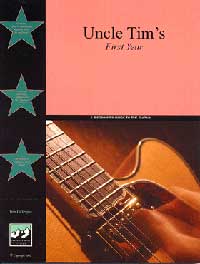
Yes, you should!
Music is key based. You are always in one key or another. Always!
Yet playing a guitar is not taught that way! Why?
Once you understand keys and the chords and scales that come from keys, the whole world of music opens up before your eyes!
Suddenly everything is MUCH easier. And it totally makes sense when you get into it.
For $15, you can put this all to rest right now. Pick up a copy today.
eBooks are delivered instantly!
By Tim Gillespie
What we are going to discuss is as important as anything you will do on a guitar. It is fundamental to achieving the higher levels of ability and it will affect everything you play on a guitar from the very beginning.
If you are a beginner, I strongly suggest you embrace this month's column and go through the entire process. If you are an intermediate player and you are having trouble making the pick hand do what you want, this will elevate your abilities quickly. No matter how developed your skills are, if you focus on the pick hand you will see improvement. And not just with what we are working on, improvement will bleed over to all the other things you do with this hand. We are going to develop and improve the control you can achieve with this very misunderstood hand. So, let's get started.
When you play a guitar, you do so with two hands. One hand
controls the exact notes that are going to be played and the other hand
actually sounds the note by vibrating the strings. For a right handed
guitarist, your left hand controls what happens on the fretboard. Your
right hand strikes the strings and creates the sound. As usual there are
methods and tricks that will not conform to this, but for the most part,
this is how you interface with the guitar.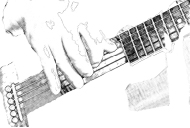
The left hand gets most of the attention at first. Most people try to figure out how to play chords and then just brush the strings with a pick or their fingers. It is common to see people focus intently on the fretboard hand and almost not at all on the pick hand. Eventually most people will ask "how do I hold the pick". Striking the string is a simple way and is easier (at first) that controlling the fretboard hand. So the fretboard hand naturally gets more attention. But at some point a person gets a little comfortable with holding down strings and then becomes aware that the pick feels funny. Or something like that. The point of this observation is to illustrate that we often times focus on what the fretboard hand is doing to the detriment of the pick hand. After all the fretboard hand is a very big part of playing guitar. Much of the action takes place there. But the notion of coordination implies that you are coordinating two hands. After a while the right hand can become a limiting factor to getting better, but it is often times not identified as a bottleneck.
One of the great and hidden benefits of playing scales is the process of engaging both hands. Scales require that each note be sounded and each hand is one half of the process. Your left hand must press down the note directly before the right hand strikes the string. The two must act in unison. When I see people play scales for a few months, this is usually the first big head game to understand. A person struggles with coordinating both hands and spends the first few weeks memorizing the scale and getting both hands on the same page. Soon the person can play the scale. After a few more weeks the person may think, OK I've got this. A rudimentary skill level has been achieved so the person starts to doubt what benefit will come from more practice time. The head game is; this is the first chance to derail a person bent on playing scales. You don't see the benefit and practice becomes boring. The law of diminishing returns sets in. So in to your head creeps the quiet whisper "let's do something else". If a person does, the scale process stops. And so does the learning that scales bring.
The reason I went into that is because of one important reason. Control. With the scale example, the issue is the level of control. How much do you have. It is common for people to attain a small degree of control and think that is all the will get and they should move on to something else. For the person that perseveres, come the real gains. There is control and there is control. If you play scales for five to ten years you will attain a very high level of control. You will make the exact motions to do what you want and nothing more. There is very little wasted motion. Stray notes are not a concern any more because you know exactly where your fingers are. They don't stray off course much.
And scales give you more control which you can use to play chords. That control you develop doesn't go away when you strum a chord, it kicks in. You play chords better, much better. People that stop playing scales never sniff these higher levels of ability and control. They make due with what they have and try to compensate with other tricks. The same learning path occurs with the right hand. The same issues apply and the same control hangs in the balance.
My Personal Learning Experience
I started out playing Classical Guitar for my first three years. Right away I put myself on a course to be able to finger pick the standard learning songs in guitar books. I learned Greensleeves and other classical material. I play some pieces by Fernando Sor, still one of my favorite composers, and others. I would play arpeggios every day for an hour and I developed a medium level of control within two years. Finger picking is much easier to learn than playing with a pick. A wedge of plastic takes time to control. Fingers are much easier to use to control the guitar. So it comes much quicker for most people. Once again I am talking about a high level of control, not just the ability to strum a few songs. This includes alternate bass lines, mixing different picking patterns and combining picking with strumming and scale runs. Using all these skills without making many mistakes takes serious control. Control, I believe, anyone can develop.
After three years I wanted to play an acoustic guitar and that meant learning to use a pick. My level of ability took a giant step backwards. My fretboard hand was very developed but my pick hand (with a pick) was very weak. Arpeggios were hard and not very fun. I could not generate an emotional statement with a pick. Many ideas for songs went undeveloped because I couldn't play it. What a hit that was.
Of course I stilled played scales and that process soon helped to give me some control, but flat picking was still way out there. Strumming and scale runs were my mainstay back then and my ability to improvise a lead was something I clung to. I could do it well and I did it alot So eventually I would finger pick without a pick and then use a pick to play lead guitar. My ability to play rhythm guitar was flat out bad. The different spacing of strings introduces another problem and steel strings are harder to press down than nylon strings.
But I was determined once again to experience the freedom that a high level of control will allow. So I went on a mission to combine finger picking and a pick. It is that experience that I an going to share in an effort to show what is necessary to really take a serious bite of out this subject and elevate your ability to control the instrument.
The first thing I did was to clear out a block of time. I was going to commit time to this direction and put in serious hours. My previous learning experiences taught me how to go about this. Consistency over several months was absolutely necessary. Otherwise it doesn't get done. Here is what I did.

 The first few weeks my goal was to play this for at least
one half hour a day, on top of the other things I played. I ended up stretching
this time into one hour a day on most days. I would play one or two chords
only, and easy ones at that. I would then repeat an arpeggio using the
pick to play the base note and three fingers to play one treble string
each. D major and A major work well for this simple exercise.
The first few weeks my goal was to play this for at least
one half hour a day, on top of the other things I played. I ended up stretching
this time into one hour a day on most days. I would play one or two chords
only, and easy ones at that. I would then repeat an arpeggio using the
pick to play the base note and three fingers to play one treble string
each. D major and A major work well for this simple exercise.
My goal was to exercise the muscles in my pick hand and get them working smoothly. One hour a day for three weeks, only using a few chords, and concentrating on exactly what the right hand was doing. And here is what it was doing. My hand was getting used to the idea of sequentially striking the strings with the other fingers
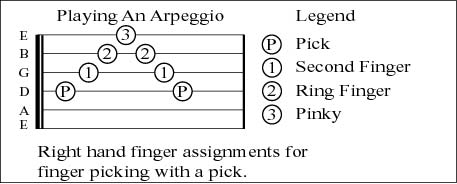 My pinkie was the renegade of the bunch at first. I would
have trouble getting it to line up and hit the right string. It would
drift over to the next string and throw everything off. If I concentrated
on the middle four strings I had trouble staying away from the high E
string. Ping, ping, ping from the high E string would show up from time
to time. After a while this would not happen until 20 to 30 minutes into
the session when the muscles started to fatigue. At first you can get
the mechanics right but if you keep playing, things start to break down.
Taking short breaks and then coming back works well, but also getting
control of your fingers during this fatigue is very important. I would
also suggest you read this months column by Dr. Jameson concerning the
issue of taking breaks. This is where I felt like I was telling my fingers
they will play what I say and I command it. This is why I would play only
a simple chord or two. I don't want any distractions while I get control
of my fingers. I need to think only about hitting the notes exactly on
line and developing some fluid mechanics. You can definitely tell when
you begin to work through this. You can feel the deeper sense of control
develop. No one has to tell you, you know!
My pinkie was the renegade of the bunch at first. I would
have trouble getting it to line up and hit the right string. It would
drift over to the next string and throw everything off. If I concentrated
on the middle four strings I had trouble staying away from the high E
string. Ping, ping, ping from the high E string would show up from time
to time. After a while this would not happen until 20 to 30 minutes into
the session when the muscles started to fatigue. At first you can get
the mechanics right but if you keep playing, things start to break down.
Taking short breaks and then coming back works well, but also getting
control of your fingers during this fatigue is very important. I would
also suggest you read this months column by Dr. Jameson concerning the
issue of taking breaks. This is where I felt like I was telling my fingers
they will play what I say and I command it. This is why I would play only
a simple chord or two. I don't want any distractions while I get control
of my fingers. I need to think only about hitting the notes exactly on
line and developing some fluid mechanics. You can definitely tell when
you begin to work through this. You can feel the deeper sense of control
develop. No one has to tell you, you know!
Once the mechanics start to show consistency, it is time to add more chords and maybe even a different picking pattern or two. For this example I am going to use the key of D major. And for very good reasons. D major works very well for developing an alternate bass line. You can pick both the open D string and the open A string and limit the chording to the upper three strings, the treble strings.
 Notice this example shows how to alternate pick. The yellow
"P" is the first note in the repeating cycle. So now we can
practice alternate picking and see what breaks down. Something probably
will. At first you may be able to do this exercise but if you do it for
30 minutes, fatigue will cause one or more fingers to develop problems.
Working through this will not only identify the weak links, but you can
also correct and refine your motions.
Notice this example shows how to alternate pick. The yellow
"P" is the first note in the repeating cycle. So now we can
practice alternate picking and see what breaks down. Something probably
will. At first you may be able to do this exercise but if you do it for
30 minutes, fatigue will cause one or more fingers to develop problems.
Working through this will not only identify the weak links, but you can
also correct and refine your motions.
At this point, I might add another chord and start to play a simple progression. At first do not change strings, keep picking the same strings as shown above. Do not add complexity until this becomes very familiar.
Here are the next chords to play using this picking pattern above.



These three chords offer a little trick that can make it easier to play them and allow you to concentrate on your right hand. You can play these chords without lifting your index finger on your fretboard hand. This requires that you play all notes on the G string with your index fingers. You don't have to do this, but I find it easier and it is fun. So play these chords and pick an arpeggio. For you to play this correctly may take a few days. You may get it at first only to lose the ability when your fingers begin to experience fatigue. It is harder to control your fingers when they get tired and start to cramp. Taking a short break and coming right back can bring back some ability. What you are doing is really getting intimate with your fingers and muscle groups. This is how you establish control. When you can do this easily with very few mistakes, try altering the picking pattern to switch strings. This increase in complexity will probably cause some mistakes.
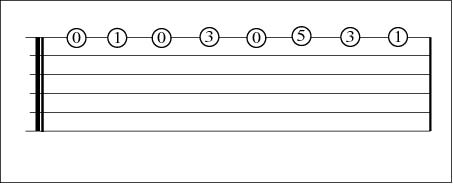 Now we are playing only the middle strings. At first no
alternate bass lines are used. You may find yourself hitting the high
E string with your pinkie For me this was common.
Now we are playing only the middle strings. At first no
alternate bass lines are used. You may find yourself hitting the high
E string with your pinkie For me this was common.
The more you play this the more comfortable you become and the more you know exactly where your fingers are at all times.
You should be able to play the notes for the middle strings with no other notes ringing. Then jump back to the upper strings.
 I would spend a few weeks on this before doing anything
in this column below this point.
I would spend a few weeks on this before doing anything
in this column below this point.
Use the upper four strings for this D major chord.
Use the middle four strings for the A major chord.
Use the lower four strings for the E major chord.


 Do you have problems switching strings while you switch
chords and still hit the exact right notes at the exact right time? We
are slowly adding complexity and using our present skill level to gain
more skill and more control. Each time we add something, it gets harder
to play it correctly. It demands more control and we introduce more places
for things to break down. There is control and then there is control.
Do you have problems switching strings while you switch
chords and still hit the exact right notes at the exact right time? We
are slowly adding complexity and using our present skill level to gain
more skill and more control. Each time we add something, it gets harder
to play it correctly. It demands more control and we introduce more places
for things to break down. There is control and then there is control.
I usually dedicate an entire session to this drill or until I am sure I can play it on demand. That may take more than one session. And I suggest you continue to play this exercise for the next two or three weeks. After about two weeks of this, you should start to develop some confidence in your ability to finger pick with a pick. But over the next two or three months that ability will grow and become ingrained. Remember we are after a deep level of control.
After a while someone could wake you in your sleep, tell you to play this and you could do it. Your finger motions start to become automatic.
In an effort to keep it interesting, I would then launch a full study into a key and finger pick while my fretboard hand plays all over the fretboard. One of the first drills for this includes triads. Anyone who has read my posts on the subject at alt.guitar.beginner knows I am feverish about triads. If the theory bugs you, turn it off. Simply play the dots and don't worry about chord construction or any rules of music. Focus on finger picking the triads from top to bottom. Play them in order and go right up the fretboard towards the sound hole (for an acoustic).
Here are the triads for the key of D major (first inversion), for the highest two string sets. Play these as a cascade. At first only use the right hand example with the highest three strings. Do not jump around until you can do it without losing much control. This will be different for everyone. You will have to be the judge of when it is enough.
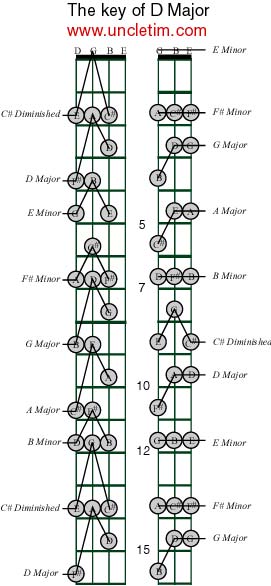 Practice playing these chords as you pick arpeggios. Start with the open
string chords on the highest string set and progress right down/up the
cascade. Play the open string D note as the bass then with time add alternate
picking using the open A string. If you need to strum the chords alone
at first, go ahead and make sure you are familial with them so you can
concentrate on finger picking.
Practice playing these chords as you pick arpeggios. Start with the open
string chords on the highest string set and progress right down/up the
cascade. Play the open string D note as the bass then with time add alternate
picking using the open A string. If you need to strum the chords alone
at first, go ahead and make sure you are familial with them so you can
concentrate on finger picking.
Several new dynamics are added here. Now we are playing up the strings and the tension is changing. Also the exact position of the strings is changing because they are being pressed at different locations. This is a very slight change, but it is enough to throw some people off at first. Additional chords must be managed as well. Remember we are trying to find the weak spots through practice. Don't get discouraged, your body and mind will eventually sort it all out. If you are having trouble, slow everything down.
By using the key of D major here, we can use the open string D note and keep it somewhat simple. As stated before add the open A string as an alternate bass when you are able.
For those of you who like a little background information, notice these are only the chords in D major. All the notes in the diatonic signature for D major are used and we are climbing through the key. We are actually playing three note scales. Check it out for yourself. Each string climbs (alphabetically) one note for each new chord.
Eventually you can play the triads on the neighboring strings. I am including the next set so you can switch string sets and add a little more complexity and interest as you progress. But remember the idea is to master the arpeggios in different circumstances. Go slowly and build on good technique. Do not rush this. These triad exercises should take two to three weeks of intense practice. Remember we are trying to develop medium to high levels of ability here. This will take time.
The pay off you will get from this is huge, and it will stick with you long after you have moved on with your music. This is only one example of how technicians will isolate motions and improve control. If you do this you will get better. Promise!
Here is one more way of mixing things up. We are going to stay in the key of D major but now we are going to play chords with more notes. These are examples of exploring the chords in D major again. I would encourage you to go beyond these combinations and find your own. You know what sounds good to you when you stumble upon it. Experiment!
Chords in the key of D major.

Choosing which string sets to play will be one of the biggest concerns with this exercise. That will vary with each chord after a while. I am leaving that up to you. But I do want to give you an idea of the different combinations you can try. Here are some samples. For this exercises develop a nice picking pattern and start to try out different chord progressions. Stay on the same string sets at first.
















Notice how this example above climbs right up the scale of chords from E minor to A major.














All we are doing is creating a progression in the key of D and sampling the sounds as we finger pick. At any time you can combine triads with this and expand the area you cover. Do not be surprised if you go off an a tangent and find some chords that would make a nice song. Run with it. If your mind wants to explore something, take the time to let it wander.
If this material is played for a period of at least three months, nearly every day for at least 30 to 60 minutes, you may expect to see wholesale changes to your abilities. After you put in time with this, go play some favorite songs whatever way you like and see if some small improvements in abilities show up. These will emerge and get better with time. These exercises will help everything.
If a guitarist is to move to the more advanced levels, then exercises like these will set the foundation in place. The level of comfort will surely grow and these new skills will show up every day for the rest of your life. Once attained these skills will never go away and you can use them to shape your music in the way you want.